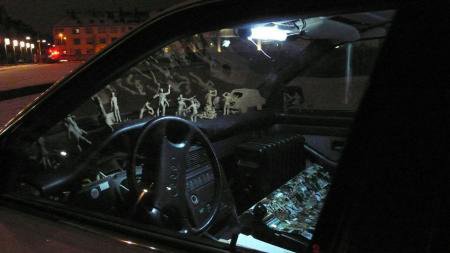InterAction
dal 29/10/2011 al 16/12/2011
Segnalato da
Wamidh Al Ameri
Maryam Motallebzadeh
Myriam Schahabian
Shahram Entekhabi
Afsoon Hassan Sharif
Nedim Kufi
29/10/2011
InterAction
AB Gallery, Luzern
Art & Media Crossing. The group exhibition of AB Gallery, with Wamidh Al-Ameri, Maryam Motallebzadeh, Myriam Schahabian, Shahram Entekhabi, Afsoon, Hassan Sharif and Nedim Kufi presents a selection of artistic statements at the interface creative tension between art and the media.

Artistic and medial images are frequently regarded as diametrically opposed poles of what can and should be expressed visually. There appears to be a normative-aesthetic division of our imagery into high and low, 'serious' and 'light'. While the purpose of art is deemed to be condensing the super-temporal uniquely into an aesthetic form, the medial image is expected primarily to document daily events, arouse attention and, in doing so, reach a wide audience.
Nevertheless, art and the media enjoy fertile interaction.
Right now, the issue of the role of the media has thrown up the question of democracy and freedom of expression particularly in the Arab countries and Middle East. The media's "flash-in-the-pan images" gives us undeniable evidence of what can be publicly negotiated in a society at the visual level – and what, conversely, cannot be said openly. Art has the (often limited) freedom to reflect on these boundaries, to explore them and redefine them. Not only the images, the organs of the media, too, have their part to play in art as symbols of unlimited freedom of speech, liberty, protest. The group exhibition of AB Gallery, Lucerne, with Wamidh Al-Ameri (Iraq-Switzerland), Maryam Motallebzadeh (Iran-Germany), Myriam Schahabian (Iran-Germany), Shahram Entekhabi (Iran-Germany), Afsoon (Iran-London), Hassan Sharif (UAE) and Nedim Kufi (Irak-Egypt-Holland) presents a selection of artistic statements at the interface creative tension between art and the media.
Afsoon frequently works with found pictorial material, which she composes into a whole in the form of sophisticated collages. For her series "Persian Speaking Objects" and "Freedom Speaking Objects" the artist has stylised everyday objects into pictograms. With these works Afsoon focuses on the cross-over point of her private day-to-day life and public politics and, in doing so, calls for the freedom of media channels through the analogy of silent objects. Maryam Motallebzadeh creates impressive, spatial installations from metre-long paper ribbons. The ribbons are made up of torn-up diaries and private memorabilia, which bear an inward-facing statement and allow a new order emerging from aggression and destruction in accordance with the principle of contingency.
Hassan Sharif's series "Communication" presents views of roofs that are dynamic both colour and composition. Central motif of the works is to be found in the round satellite dishes which appear to be swaying in the wind corresponding to the colourful architecture. Hassan Sharif highlights in a figurative-atmospheric way the potential for global information and understanding.
Inspired by the television channel Al Jazeera, which provides a simultaneous translation of the news for deaf viewers Nedim Kufi created his work "Deaf News". Kufi describes the quality of communication in gestures as direct, solid, intensive, sharp and narrative – in doing so he addresses a fundamental problem: the fact that the presentation of reality can never be objective – it is shaped, but its shaping is without abstraction.
With her multimedia installation "Limits of Control" Myriam Schahabian makes explicit reference to the current political situation in Iran by making the artistic link to current events and history. Within the framework of an automobile she shows Youtube Handy filming of recent events positioning a film of driving along Teheran's most famous main street. She illustrates that these recent manifestations – very much thanks to the use of modern media – can no longer be controlled, contained or ignored by those in power.
With his series "Islamic Vogue" Shahram Entekhabi has found a visually striking formula to critically address the dictate of the veiling of women. He starts by targeting the retroactive censorship of unveiled women in books and magazines in public libraries in Iran as a consequence of the Islamic revolution at the end of the 1970s.
Wamidh Al-Ameri's work "Paradise" deals with the issue of the war in Iraq in an elementary way and combines a variety of medial levels into a single entity that engages the viewer. The work portrays a scene from paradise – one which deliberately refrains from referring to Christian traditions of representation. Instead, it depicts the paradise of the future as described in the Koran. In medial contrast to this, information on the war in Iraq is continually projected via the painting – from the first day of the war right up to the end of the exhibition.
Image: Myriam Schahabian: Limits of Control
Autoinnenraum mit Clay People
Opening: 30 October 2011 - 11:00
AB Gallery
Arealstrasse 6 (Emmenbrucke) - Luzern
Opening Hours: Thur/Fri 2 - 7 pm, Sat 11 am - 4 pm, and by appointment



